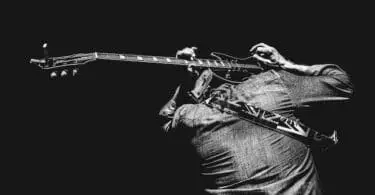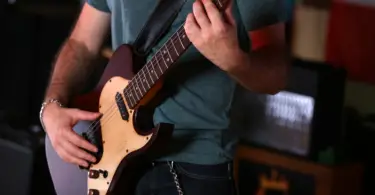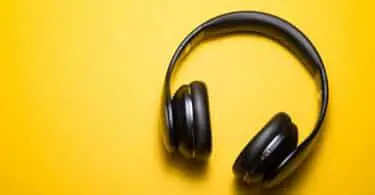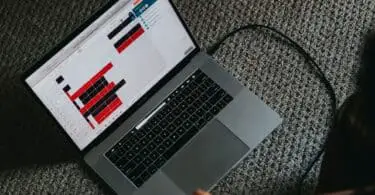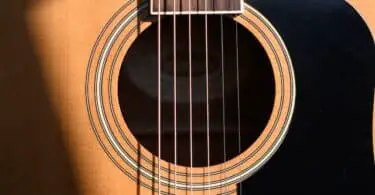Guitar pedal is a component used to manipulate the sound or tone produced by your guitar. It is the ones that are responsible for creating special sound effects, which also help to improve the overall tone and frequency quality of the guitar instrument.
In this post, you will learn some of the different types of guitar pedals and their uses. You will also know whether or not you need these accessories in your music arsenal.
Quick Links
30 Different Type Of Pedals And Their Functions
Choosing what type of guitar pedal to use is somehow subjective, and it all depends on what type of guitar pedal you love to use and what suits your instrument well. Here are the different types of pedals and their functions.
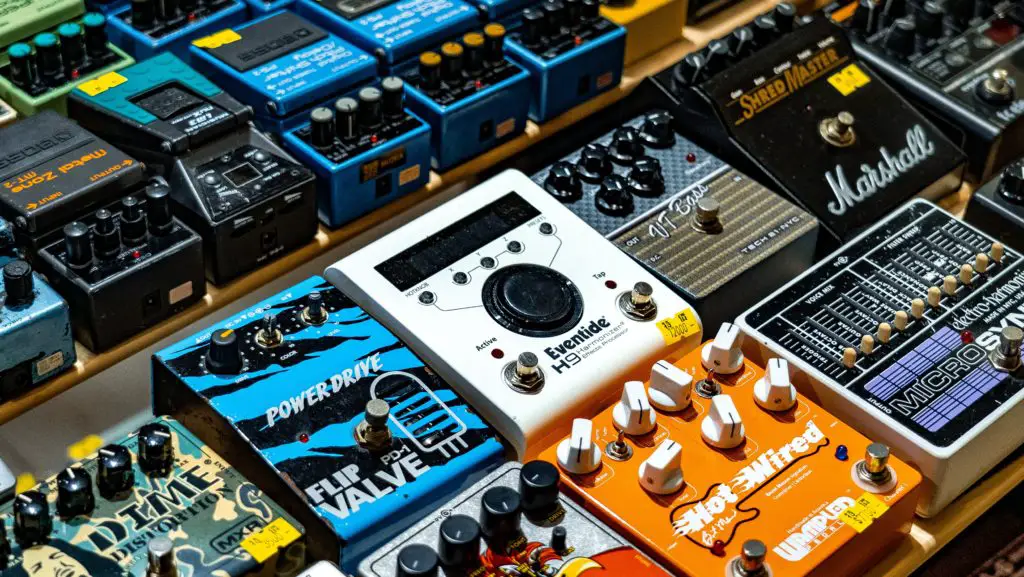
1. Flanger Pedal
This type of guitar pedal sounds like an automated Wah Pedal, producing whooshing sounds and making the pitch higher and lower. Flanger pedals make the sound more obvious than other guitar pedals and are ideal for modern metal sounds.
2. Fuzz Pedal
This type of guitar pedal makes the original sound and tone difficult to recognize. It gives the most intense sound effects that produce heavy metal and rock sounds.
3. Compression Pedal
It is a signal processor that turns down the volume of signal that decreases the dynamic range of sounds. This type of guitar pedal differs from one-knob compressors with fixed settings and attack.
The common configurations consist of two or three knobs. It includes gain adjustments and additional control, frequently combined with two functions like ratio and threshold.
4. Distortion Pedals
This type of guitar pedal comes in a wider range of styles, and it is also the most widely used guitar pedal among musicians. This guitar pedal adds an instant rock sound and tone to your guitar. It has aggressive and heavy sounds that are commonly used for producing rock and metal sounds.
5. Gain Boost Pedals
This type of guitar pedal is designed for high-impedance guitar signals. They are also called clean boosts guitar pedals.
Gain boosts guitar pedals have two main purposes; first, to compensate for the signal loss over the extensive effects of the pedal chains, which may need to be placed at the pedalboard ends. Second, gain boosts are used to hit amplifiers with extra hot signals and push them with a click of the footswitch.
6. Overdrive Pedals
It is often used as dirty boosts which drive amplifiers’ preamp while adding color and texture to the sound quality. Overdrive guitar pedals are used to stimulate the breakup when you push an amplifier to where it starts to distort.
Overdrive guitar pedals have two gain stages; the input volume, which refers to how hard you hit the effects, and the output volume, which drives the signal path. Through treble, bass, and tone-shaping controls, simple tone controls are rare for backing off higher frequencies.
7. Volume Control Pedals
These guitar pedals are ideal for creating and producing ambiance and smooth swells to your music. However, the variable level of volume control makes them less effective than other pedals like gain boost. Volume control pedals are larger rock types of pedals that produce more utility than an effect.
8. Amplifier Emulation Pedals
It offers a wider range and variety of tones. They are much alike with an amplifier that uses subtle warmth to insane drive and distortion. Whenever you use neutral amplifier emulation pedals, you will have a solid-state amplifier.
9. Looper Pedals
It is one of the easiest guitar pedals to operate. Once you step on its footswitch, you may start recording sounds. However, there are looper pedals that have complex functions because of multiple parts, features, and sync components. It is also one of the pedals used on stage; it can create continuous effects and background rhythms.
10. Loop Switcher Pedals
These loop switchers play a big role in pedalboard constructions. This type of guitar pedal has independent effects that you can switch on and off in various ranges and configurations. A single press in a loop switcher can create a massive change in tone and sound.
11. Multi-effect Pedals
These guitar pedals let you have deeper effects as they were individual pedals. However, multi-effect pedals do not have the same features as traditional pedals but can be as convenient with a single pedal.
12. Delay Pedal
From the name itself, it creates a delay in your produced sounds and signals. Delay pedals control the sound volume as well as the time intervals. If you are a guitarist who likes creating and experimenting with smooth sounds, delay pedals are best to use.
There are three types of Delay pedals; Analog Delay, Tape Delay, and Digital Delay. Analog Delay is warmer and has a bit of imperfection that brings the tone to life. It uses physical components to produce and create delay tones.
Tape Delay is a type of analog delay that uses a tape loop to create delay tones. It compresses the tones and makes a unique timbre and sounds.
Digital delay uses computer chips to create delay tones in digital signal processing. This process provides cleaner delay tones that can copy different characteristics of delay tones in one guitar pedal.
13. Wah Pedals
This type of guitar pedal is one of the easiest pedals to recognize because of its “wah” sounds. Every single pedal you step creates a “wah” sound for a higher pitch. This guitar pedal serves as a treble bass filter to emphasize more the sounds that add drama and enhancements to the rhythms.
14. Reverb Pedals
Sounds produced by reverb pedals are the most common sound and tone we hear. These are the echo effects in the music we usually hear. Other amplifiers have knobs to control this type of pedal to produce professional sounds and tones. It is also used to create a nice atmosphere for the audience or listeners.
15. Chorus Pedals
This guitar pedal gives a dramatic effect to the sounds and tones produced. It is a special complimentary effect that creates swirling and shimmering effects. It also creates a thicker and richer sound that makes the rhythm perfect.
16. Phaser Pedals
This type of guitar pedal sounds like a chorus pedal that creates a spaceship-like sound which is very famous during the 1970s. The sound effects produced by the phaser pedal are more noticeable with a single note or chord.
17. Tremolo Pedals
With the use of this guitar pedal, it can create a staggered or wobbled sound with loud volumes. As the tremolo changes, the volume, frequency, and vibrato also change. Tremolo pedals make the sound unique by defining the music style and tones.
18. Octave Pedals
This guitar pedal gives a thicker and fuller sound and tone that creates unusual guitar sounds. From the name itself, it refers to the intervals between notes of the same musical pitch. Octave pedals are capable of providing bass tones that are used in band music.
19. Noise Gate Pedals
These pedals are helpful in hiding and removing humming and buzzing noises and sounds. It cuts out all unwanted sounds when your guitar is silent or when not playing.
20. Tuner Pedals
This guitar pedal does not create sound effects, but it improves the overall sound. It helps guitarists to get the accurate tune of the guitar strings when they strum each. With a single strum to a string, the tuner pedal will show how to tune them or automatically correct the tune without emitting sounds.
21. Acoustic Pedals
This guitar pedal will give your guitar a boost in tone to make the guitar stand out even when other instruments are playing. Acoustic pedals can also lower background noise from the guitar.
22. Equalizer Pedals
It creates more interesting tones that can boost frequencies with the audio spectrum. It can also imitate small radio sounds by rolling off the bottom end and boosting the high mids.
23. Harmonizer Pedals
It creates a double effect of the guitar input signal by shifting the pitch at a certain interval. This guitar pedal is commonly used to harmonize hard rock, metal genres, and even solos. is also called an acoustic simulator that makes your electric guitar sound like acoustic guitars.
24. Rotary Pedals
This pedal is initially created for electric organs to copy the wobbling sounds of pipe organs. Other rotary pedals have two speeds, fast and slow. When using a rotary pedal, you can control the speed and the time to take switches.
25. Slicer Pedals
It gives a dynamic sound effect that sounds like a chopper. It produces sounds that turn the signal’s volume on and off and sounds like chopped or sliced.
26. Vocoder Guitar Pedal
It utilizes your guitar’s original and natural tone that takes the input of a vocal or voice microphone and sounds like it is talking.
27. Talk Box Pedals
Talk box pedals are among the famous guitar pedals. The guitar signal is pushed through a box or speaker into a tube that musicians hold in their mouths, creating the most dynamic and distinctive sound effects that have become part of the successes of famous artists.
28. Filter Pedals
This type of guitar pedal usually copies other sounds of instruments such as bass instruments, piano, and sitar. Filter pedals can create a unique sound and tone for your guitar.
29. Univibe Pedals
It can emulate the sounds of rotary speakers but in a digital way. It can produce unique sounds on its own by tweaking each modulator.
30. Buffer Pedal
This guitar pedal is a plug-and-use type, and it helps maintain the tone by converting the signal to lower impedance.
Do You Need Pedals For Guitar?
Not all guitar players need pedals, but they can be very useful for particular guitarists. Guitar pedals are not required to produce a good tone.
Some guitarists are more into directly plugging their guitars into their amps, and they utilize the amp to adjust the tone they produce. Good thing that modern amps have built-in effects.
Guitar pedals might not be necessary to produce a good guitar tone, but they can add a beautiful tone that amps can’t. Aside from that, they also let you customize your rig to how you want them to be.
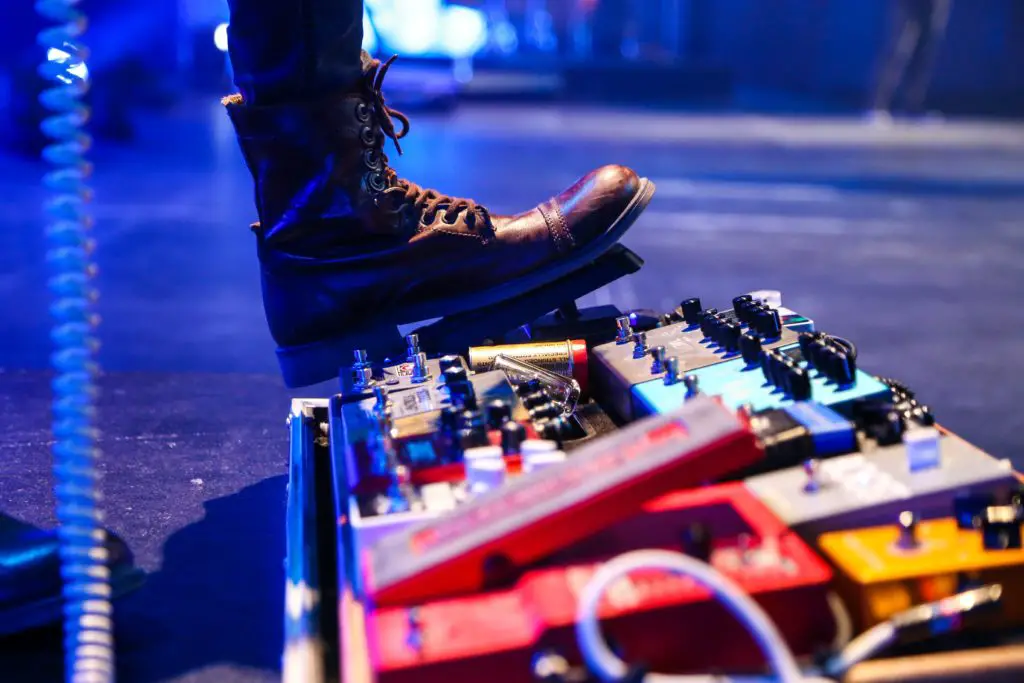
What Type Of Guitar Pedals Do I Need?
Most guitarists need to have at least a tuner, delay and drive pedal as these three are essential pedals. They provide a solid rig that guitar players won’t outgrow. While most guitarists typically buy these three guitar pedals separately, some would build huge pedalboards that come with different effects.
Some Final Words
To sum it up, all types of guitar pedals work well when utilized properly. They all create and produce sounds and can remove unwanted noises from any guitar instrument.
Guitar pedals might have huge differences in their sizes and shapes, but all can add beauty and color to your produced music.

